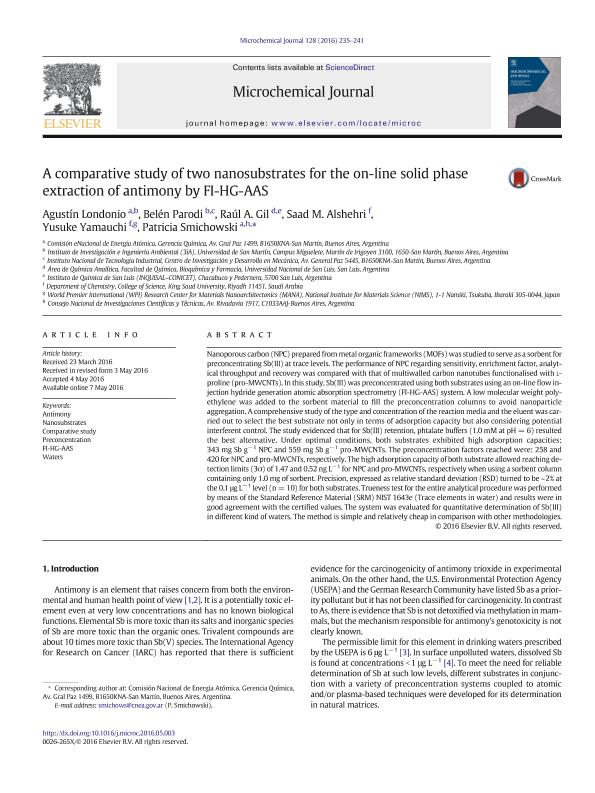Mostrar el registro sencillo del ítem
dc.contributor.author
Londonio, Juan Agustín

dc.contributor.author
Parodi, Belén
dc.contributor.author
Gil, Raul Andres

dc.contributor.author
Alshehri, Saad M.
dc.contributor.author
Yamauchi, Yusuke
dc.contributor.author
Smichowski, Patricia Nora

dc.date.available
2018-05-03T17:18:49Z
dc.date.issued
2016-09
dc.identifier.citation
Londonio, Juan Agustín; Parodi, Belén; Gil, Raul Andres; Alshehri, Saad M.; Yamauchi, Yusuke; et al.; A comparative study of two nanosubstrates for the on-line solid phase extraction of antimony by FI-HG-AAS; Elsevier Science; Microchemical Journal; 128; 9-2016; 235-241
dc.identifier.issn
0026-265X
dc.identifier.uri
http://hdl.handle.net/11336/43986
dc.description.abstract
Nanoporous carbon (NPC) prepared frommetal organic frameworks (MOFs)was studied to serve as a sorbent forpreconcentrating Sb(III) at trace levels. The performance of NPC regarding sensitivity, enrichment factor, analyticalthroughput and recovery was compared with that of multiwalled carbon nanotubes functionalised with Lproline(pro-MWCNTs). In this study, Sb(III)was preconcentrated using both substrates using an on-line flow injectionhydride generation atomic absorption spectrometry (FI-HG-AAS) system. A low molecular weight polyethylenewas added to the sorbent material to fill the preconcentration columns to avoid nanoparticleaggregation. A comprehensive study of the type and concentration of the reactionmedia and the eluentwas carriedout to select the best substrate not only in terms of adsorption capacity but also considering potentialinterferent control. The study evidenced that for Sb(III) retention, phtalate buffers (1.0 mM at pH=6) resultedthe best alternative. Under optimal conditions, both substrates exhibited high adsorption capacities:343 mg Sb g−1 NPC and 559 mg Sb g−1 pro-MWCNTs. The preconcentration factors reached were: 258 and420 for NPC and pro-MWCNTs, respectively. The high adsorption capacity of both substrate allowed reaching detectionlimits (3σ) of 1.47 and 0.52 ng L−1 for NPC and pro-MWCNTs, respectivelywhen using a sorbent columncontaining only 1.0 mg of sorbent. Precision, expressed as relative standard deviation (RSD) turned to be ~2% atthe 0.1 μg L−1 level (n=10) for both substrates. Trueness test for the entire analytical procedurewas performedby means of the Standard Reference Material (SRM) NIST 1643e (Trace elements in water) and results were ingood agreement with the certified values. The system was evaluated for quantitative determination of Sb(III)in different kind of waters. The method is simple and relatively cheap in comparison with other methodologies.
dc.format
application/pdf
dc.language.iso
eng
dc.publisher
Elsevier Science

dc.rights
info:eu-repo/semantics/openAccess
dc.rights.uri
https://creativecommons.org/licenses/by-nc-sa/2.5/ar/
dc.subject
Antimony
dc.subject
Nanosubstrates
dc.subject
Comparative Study
dc.subject
Preconcentration
dc.subject
Waters
dc.subject.classification
Otras Ciencias Químicas

dc.subject.classification
Ciencias Químicas

dc.subject.classification
CIENCIAS NATURALES Y EXACTAS

dc.title
A comparative study of two nanosubstrates for the on-line solid phase extraction of antimony by FI-HG-AAS
dc.type
info:eu-repo/semantics/article
dc.type
info:ar-repo/semantics/artículo
dc.type
info:eu-repo/semantics/publishedVersion
dc.date.updated
2018-05-03T14:00:01Z
dc.journal.volume
128
dc.journal.pagination
235-241
dc.journal.pais
Países Bajos

dc.journal.ciudad
Amsterdam
dc.description.fil
Fil: Londonio, Juan Agustín. Comisión Nacional de Energía Atómica; Argentina. Universidad Nacional de San Martín; Argentina
dc.description.fil
Fil: Parodi, Belén. Universidad Nacional de San Martín; Argentina. Instituto Nacional de Tecnología Industrial; Argentina
dc.description.fil
Fil: Gil, Raul Andres. Consejo Nacional de Investigaciones Científicas y Técnicas. Centro Científico Tecnológico Conicet - San Luis. Instituto de Química de San Luis. Universidad Nacional de San Luis. Facultad de Química, Bioquímica y Farmacia. Instituto de Química de San Luis; Argentina. Universidad Nacional de San Luis. Facultad de Química, Bioquímica y Farmacia. Departamento de Química. Área de Química Analítica; Argentina
dc.description.fil
Fil: Alshehri, Saad M.. King Saud University; Arabia Saudita
dc.description.fil
Fil: Yamauchi, Yusuke. King Saud University; Arabia Saudita. Tsukuba University. National Institute For Materials Science; Japón
dc.description.fil
Fil: Smichowski, Patricia Nora. Consejo Nacional de Investigaciones Científicas y Técnicas; Argentina. Comisión Nacional de Energía Atómica; Argentina
dc.journal.title
Microchemical Journal

dc.relation.alternativeid
info:eu-repo/semantics/altIdentifier/doi/http://dx.doi.org/10.1016/j.microc.2016.05.003
dc.relation.alternativeid
info:eu-repo/semantics/altIdentifier/url/https://www.sciencedirect.com/science/article/pii/S0026265X16300546
Archivos asociados
